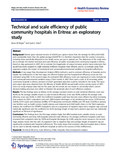| dc.description.abstract | Eritrean gross national income of Int$610 per capita is lower than the average for Africa (Int$1620) and considerably lower than the global average (Int$6977). It is therefore imperative that the country’s resources,including those specifically allocated to the health sector, are put to optimal use. The objectives of this study were (a) to estimate the relative technical and scale efficiency of public secondary level community hospitals in Eritrea, based on data generated in 2007, (b) to estimate the magnitudes of output increases and/or input reductions that would have been required to make relatively inefficient hospitals more efficient, and (c) to estimate using Tobit regression analysis the impact of institutional and contextual/environmental variables on hospital inefficiencies.A two-stage Data Envelopment Analysis (DEA) method is used to estimate efficiency of hospitals and to explain the inefficiencies. In the first stage, the efficient frontier and the hospital-level efficiency scores are first estimated using DEA. In the second stage, the estimated DEA efficiency scores are regressed on some institutional and contextual/environmental variables using a Tobit model. In 2007 there were a total of 20 secondary public community hospitals in Eritrea, nineteen of which generated data that could be included in the study. The input and output data were obtained from the Ministry of Health (MOH) annual health service activity report of 2007.
Since our study employs data that are five years old, the results are not meant to uncritically inform current decision-making processes, but rather to illustrate the potential value of such efficiency analyses.The key findings were as follows: (i) the average constant returns to scale technical efficiency score was 90.3%; (ii) the average variable returns to scale technical efficiency score was 96.9%; and (iii) the average scale efficiency score was 93.3%. In 2007, the inefficient hospitals could have become more efficient by either increasing their outputs by 20,611 outpatient visits and 1,806 hospital discharges, or by transferring the excess 2.478 doctors (2.85%), 9.914 nurses and midwives (0.98%), 9.774 laboratory technicians (9.68%), and 195 beds (10.42%) to primary care facilities such as health centres, health stations, and maternal and child health clinics. In the Tobit regression analysis, the coefficient for OPDIPD (outpatient visits as a proportion of inpatient days) had a negative sign, and was statistically significant; and the coefficient for ALOS (average length of stay) had a positive sign, and was statistically significant at 5% level of significance.The key findings were as follows: (i) the average constant returns to scale technical efficiency score was 90.3%; (ii) the average variable returns to scale technical efficiency score was 96.9%; and (iii) the average scale efficiency score was 93.3%. In 2007, the inefficient hospitals could have become more efficient by either increasing their outputs by 20,611 outpatient visits and 1,806 hospital discharges, or by transferring the excess 2.478 doctors (2.85%), 9.914 nurses and midwives (0.98%), 9.774 laboratory technicians (9.68%), and 195 beds (10.42%) to primary care facilities such as health centres, health stations, and maternal and child health clinics. In the Tobit regression analysis, the coefficient for OPDIPD (outpatient visits as a proportion of inpatient days) had a negative sign, and was statistically significant; and the coefficient for ALOS (average length of stay) had a positive sign, and was statistically significant at 5% level of significance.The findings from the first-stage analysis imply that 68% hospitals were variable returns to scale technically efficient; and only 42% hospitals achieved scale efficiency. On average, inefficient hospitals could have increased their outpatient visits by 5.05% and hospital discharges by 3.42% using the same resources. Our second- stage analysis shows that the ratio of outpatient visits to inpatient days and average length of inpatient stay are significantly correlated with hospital inefficiencies. This study shows that routinely collected hospital data in Eritrea can be used to identify relatively inefficient hospitals as well as the sources of their inefficiencies. | en_US |

